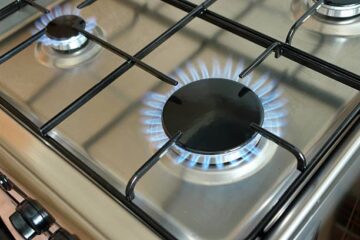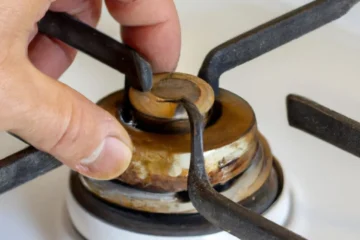Installing a microwave over the stove is a great way to save counter space in the kitchen. It’s a popular choice for homeowners who want to have a functional and efficient kitchen without sacrificing style. However, installing a microwave over the stove can be a bit tricky, especially if you’re not familiar with the process.
In this article, readers will learn how to install a microwave over the stove in a few easy steps. The article will cover everything from measuring the space to mounting the microwave and connecting the ductwork. With clear and concise instructions, readers will be able to follow along and successfully install their own microwave over the stove. Whether you’re a seasoned DIYer or a beginner, this article will provide you with the knowledge and confidence you need to tackle this project.
Tools and Materials
Required Tools
Installing a microwave over the stove requires some basic tools. These tools include:
- Measuring tape
- Stud finder
- Pencil
- Level
- Drill and drill bits
- Screwdriver
- Wire cutters
- Needle-nose pliers
- Drywall saw
- Masking tape
- Drop cloth or towel
- Scissors
Required Materials
In addition to the tools, you will need the following materials to install a microwave over the stove:
- Over-the-range microwave
- Cardboard mounting templates (mounting bracket may be used as a template)
- Toggle bolts
- Mounting screws
- Power drill
- Power cord
- Cable outlet boxes
- Receptacle
It is important to note that some of these materials may come with the microwave, while others may need to be purchased separately. Before beginning the installation process, it is important to gather all the required tools and materials to ensure a smooth installation process.
Preparation
Before installing a microwave over the stove, it is important to properly prepare the area. The following sub-sections will outline the necessary steps to take before beginning the installation process.
Measure the Space
The first step in preparing to install a microwave over the stove is to measure the space where the microwave will be installed. It is important to ensure that the microwave will fit properly in the space and that there is enough clearance above the stove.
Measure the width and height of the space and compare it to the dimensions of the microwave. It is also important to measure the distance from the bottom of the cabinet to the stove top to ensure that there is enough clearance for cooking.
Clear the Area
Before beginning the installation process, it is important to clear the area around the stove. Remove any items from the stove top and nearby countertops to prevent them from falling or getting in the way during installation.
It is also important to turn off the power to the stove and the area where the microwave will be installed. This can be done by turning off the circuit breaker or unplugging the stove.
Once the area is clear and the power is turned off, it is time to begin the installation process. By properly preparing the area, the installation process will be smoother and safer.
Installation
Installing a microwave over a stove can be a great way to save counter space and add convenience to your kitchen. Here are the steps to follow for a successful installation.
Mounting Bracket Installation
The first step is to install the mounting bracket. Most microwaves come with a mounting bracket that needs to be attached to the wall. Follow the manufacturer’s instructions to determine where to place the bracket and how to attach it to the wall. Make sure the bracket is level and securely attached to the wall.
Hanging the Microwave
Once the mounting bracket is in place, the next step is to hang the microwave. This step is best done with two people. One person should hold the microwave while the other person attaches it to the mounting bracket. Follow the manufacturer’s instructions to determine how to attach the microwave to the bracket. Make sure the microwave is level and securely attached to the bracket.
Electrical Connection
The final step is to connect the microwave to the electrical outlet. Follow the manufacturer’s instructions to determine how to do this. Make sure the microwave is properly grounded and that all electrical connections are secure.
Testing
Testing the Microwave
Once the microwave is installed, it is important to test it to ensure that it is working properly. Here are some steps to follow when testing the microwave:
- Turn on the microwave and set it to the highest power setting.
- Place a cup of water in the microwave and heat it for one minute.
- After one minute, check the temperature of the water. It should be hot, but not boiling.
- If the water is not hot, or if the microwave is making strange noises, turn it off immediately and check the installation to make sure everything is secure and properly connected.
- If the microwave is working properly, test it with different types of food to make sure it is heating evenly and thoroughly.
It is important to note that microwaves can vary in power and heating capabilities, so it may take some trial and error to find the right settings for different types of food. It is also important to follow the manufacturer’s instructions for using the microwave, including recommended cooking times and power settings.
Safety Precautions
When testing the microwave, it is important to follow these safety precautions:
- Never operate the microwave with nothing inside.
- Do not use metal or aluminum foil in the microwave.
- Do not overheat food in the microwave.
- Keep the microwave clean and free of debris to prevent fires.
- If the microwave is making strange noises or emitting unusual odors, turn it off immediately and unplug it.
Safety Tips
When installing a microwave over the stove, it is important to follow certain safety tips to avoid accidents or injuries. Here are some tips to keep in mind:
- Turn off the power: Before starting the installation process, make sure to turn off the power to the area where the microwave will be installed. This can be done by flipping the circuit breaker or unplugging the power source.
- Use a stud finder: When mounting the microwave, it is important to use a stud finder to locate the studs in the wall. This will ensure that the microwave is securely mounted and will not fall off.
- Follow the manufacturer’s instructions: It is important to follow the manufacturer’s instructions when installing the microwave. This will ensure that the installation is done correctly and safely.
- Wear protective gear: When drilling or cutting through the wall, it is important to wear protective gear such as safety glasses and gloves. This will protect you from any debris or dust that may be generated during the installation process.
- Check for proper ventilation: Make sure that the microwave is properly ventilated to prevent the buildup of steam and smoke. This can be done by connecting the ductwork to the microwave vent outlet.
- Don’t overload the microwave: Make sure that the microwave is not overloaded with heavy items or too much food. This can cause the microwave to become unbalanced and fall off the wall.
Conclusion
Installing an over-the-range microwave oven can be a great way to save space in the kitchen. With the right tools and a clear understanding of the steps involved, it is a project that can be completed in a few hours.
It is important to carefully read and follow the manufacturer’s instructions when installing a microwave. This will ensure that the appliance is installed correctly and safely.
One of the most important steps in the installation process is to locate the studs in the wall. This will provide a secure base for the microwave to be mounted on.
Another key consideration is the ventilation system. It is important to ensure that the microwave is properly vented to the outside of the house. This will prevent moisture and odors from building up in the kitchen.
Overall, installing an over-the-range microwave can be a great DIY project for homeowners. With the right tools and a little bit of patience, it is a project that can be completed in a few hours. By following the manufacturer’s instructions and taking the time to do the job right, homeowners can enjoy the benefits of a space-saving and convenient appliance in their kitchen.



